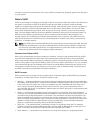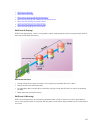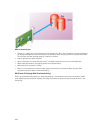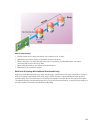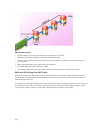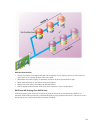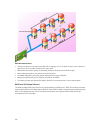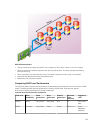
• Stripe element size — The amount of disk space consumed by a stripe element. For example, consider
a stripe that contains 64KB of disk space and has 16KB of data residing on each disk in the stripe. In
this case, the stripe element size is 16KB and the stripe size is 64KB.
• Parity — Parity refers to redundant data that is maintained using an algorithm in combination with
striping. When one of the striped disks fails, the data can be reconstructed from the parity information
using the algorithm.
• Span — A span is a RAID technique used to combine storage space from groups of physical disks into
a RAID 10, 50, or 60 virtual disk.
RAID Levels
Each RAID level uses some combination of mirroring, striping, and parity to provide data redundancy or
improved read and write performance. For specific information on each RAID level, see Choosing RAID
Levels.
Organizing Data Storage For Availability And Performance
RAID provides different methods or RAID levels for organizing the disk storage. Some RAID levels
maintain redundant data so that you can restore data after a disk failure. Different RAID levels also entail
an increase or decrease in the I/O (read and write) performance of a system.
Maintaining redundant data requires the use of additional physical disks. The possibility of a disk failure
increases with an increase in the number of disks. Since the differences in I/O performance and
redundancy, one RAID level may be more appropriate than another based on the applications in the
operating environment and the nature of the data being stored.
When choosing a RAID level, the following performance and cost considerations apply:
• Availability or fault-tolerance — Availability or fault-tolerance refers to the ability of a system to
maintain operations and provide access to data even when one of its components has failed. In RAID
volumes, availability or fault-tolerance is achieved by maintaining redundant data. Redundant data
includes mirrors (duplicate data) and parity information (reconstructing data using an algorithm).
• Performance — Read and write performance can be increased or decreased depending on the RAID
level you choose. Some RAID levels may be more appropriate for particular applications.
• Cost efficiency — Maintaining the redundant data or parity information associated with RAID volumes
requires additional disk space. In situations where the data is temporary, easily reproduced, or non-
essential, the increased cost of data redundancy may not be justified.
• Mean Time Between Failure (MTBF) — Using additional disks to maintain data redundancy also
increases the chance of disk failure at any given moment. Although this option cannot be avoided in
situations where redundant data is a requirement, it does have implications on the workload of the
system support staff within your organization.
• Volume — Volume refers to a single disk non-RAID virtual disk. You can create volumes using external
utilities like the O-ROM <Ctrl> <r>. Storage Management does not support the creation of volumes.
However, you can view volumes and use drives from these volumes for creation of new virtual disks
or Online Capacity Expansion (OCE) of existing virtual disks, provided free space is available. Storage
Management allows Rename and Delete operations on such volumes.
Choosing RAID Levels
You can use RAID to control data storage on multiple disks. Each RAID level or concatenation has
different performance and data protection characteristics.
The following topics provide specific information on how each RAID level store data as well as their
performance and protection characteristics:
206










